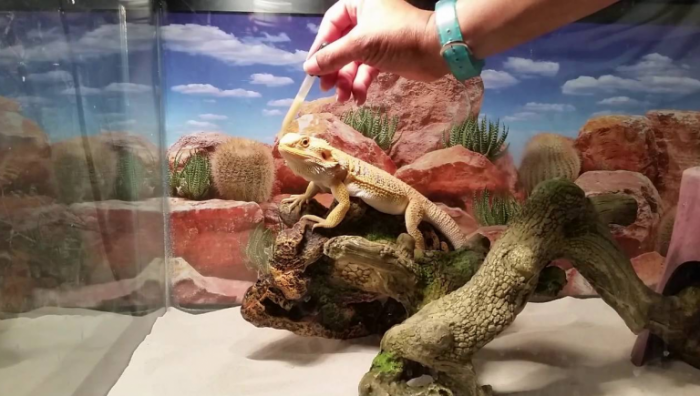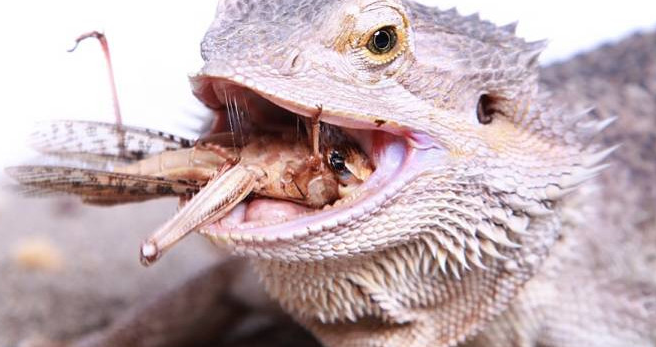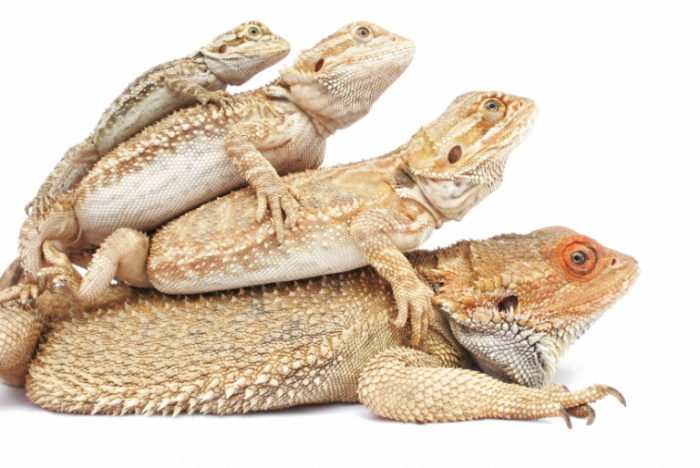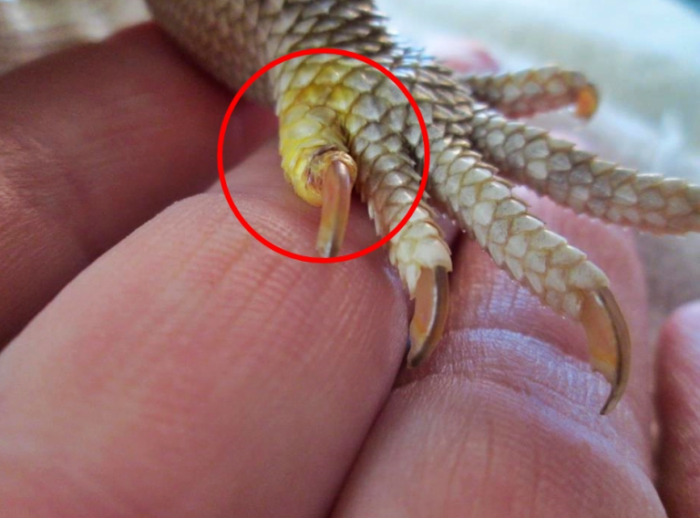Bearded dragons— these gentle beasts came all the way from Australia and are now readily available because of their willingness to breed in captivity. Beardies make a wonderful pet for both advanced and beginner reptile keepers. Because of their relatively small size and docile nature, these reptiles have become quite popular in recent years and are highly recommended for families with little kids due to their seeming love for attention.
If you are welcoming a bearded dragon to your family, then here is a complete guide for caring these gentle reptiles.
Habitat

Tank/Enclosure
The first thing you need for caring a bearded dragon is their tank or enclosure. A bearded dragon enclosure needs to be large enough for your beardie to easily move around and feel at home. Tanks that are too small may cause anxiety issues and negatively affect their growth.
Here is a guideline of suitable tank size:
|
Bearded Dragon Size |
Tank Size |
| Baby Bearded Dragons | 20 gallon |
| 10 to 16 inch Bearded Dragons | 40 gallons or larger |
| 16 to 20 inch Bearded Dragons | Minimum of 50 gallons; 75 gallons is ideal |
| 20 inches or more Bearded Dragons |
Minimum of 75 gallons, 120 gallons is ideal |
Substrate
For bearded dragon substrate, sand is commonly used, but comes with certain concern, particularly if you are keeping young lizards leading to intestinal impaction if they accidentally eat some.
Young beardies are not recommended to be kept on sand or any type of loose substrate. Reptile carpet (watch out for loose areas or threads that might snag dragon toenails), paper toweling or newspaper would be better choices.Adult beardies can also be kept with the same substrate.
If you must use sand, then go with playground sand due to the fact that it is not as dusty as other kinds of sands. You can even purchase reptile sands which are digestible, although opinions on the safety are varied. Sandmixed with clean soil which has not been treated with pesticides, fertilizers,and other harmful elements can also be used with adult bearded dragons.
Lighting
Incandescent bulbs help in providing visible white light to all areas of the tank. In addition to white light, a bearded dragon will need to have full access to natural sunlight for optimum health since it helps them in synthesizing vitamin D3 that boosts calcium absorption.
In case you can’t provide your beardie with easy access to bright sunlight, you can use special UVB bulb that provides the necessary UVB light. You will need to purchase lights which emits light in 290 to 320 nanometer range. There are some bulbs which produce only UVB lights while there are some that can provide a combination of both white lights and UVB lights.
Temperature
Bearded Dragons like it hot and a basking site of around 100° Fahrenheit works really well for them. Basking sites can be provided by a spotlight like mercury vapor bulb that is positioned over a branch or rock at one end of the tank. During the night, the temperature can go down to around 65°.
By keeping the spotlight at one end of the cage, you let your beardie to thermoregulate. The cooler end of the tank needs to be kept at around 80°.
Heat can also be provided using heat emitters, heat tape,and other devices that are available in pet stores. Just make sure that you keep a bearded dragons thermometer in the tank in order for you to track the cage temperature.
Landscaping
Bearded dragons will surely appreciate an assortment of branches for basking and climbing. Make sure that the branches you provide are secure and varying in sizes. Also, make sure that the branches are as wide as your beardie to ensure your pet’s safety and comfort. Boards covered with outdoor or indoor carpet also make a good climbing post. You can also add bearded dragon hammock where they can leisurely lounge around.
Smooth and flat-bottomed rocks are also a welcoming addition to your beardie’s habitat since they can wear down your dragon’s toenails which must be clipped often when in captivity.Bearded dragons also love somewhere to hide and you can use flower pots, cardboard tubes or empty cardboard boxes that will provide a snug fit for your pet.
Another important bearded dragon accessories to add to their tank are plants. Other than beautifying an enclosure, plants can also provide shade, humidity, sense of security and natural habitat feel. When choosing for plants to add on the tank, make sure that they are nontoxic. Some of the good choices include hibiscus, Ficus benjamina,and Dracaena. Make sure that these plants are not treated with pesticides or the potting soil does not contain any fertilizer or harmful chemicals.
Water And Humidity
Even though you dragon will receive most of its water from its foods, a fresh drinking water should always be available at all times, placed in a shallow bowl which can’t be tipped over.
Humidity levels for dragons raised in captivity are also extremely important since it is necessary for proper shedding. The suitable humidity level inside the tank should be kept between 35 and 40% which is identical to the humidity that is found in Australia’s wilderness and can be attained with a reptile humidifier.
When humidity is low, you can mist your beardie using water spray bottle several times a week.Your dragon might also appreciate a tub of water for soaking. Just make sure that the water tub allows easy exit and entrance. Also, make sure that you clean your dragon’s tub and replace its water regularly, since it may defecate or urinate in the water.
Sanitation
For sanitation, make sure that you clean your bearded dragon’s cage, water bowl and food bowl with specially formulated sanitation product. Rinse all items after cleaning and allow them to dry before re-assembling the cage and putting back your bearded dragon.
Also, because bearded dragons can harbor Salmonella bacteria, be sure to wash and sanitize your hands after handling your pet or its cage.
Nutrition

Food and Diet
Being omnivores, bearded dragon food and diet includes both plant and animal matter. These reptiles are not picky and eat whatever you give.
For younger bearded dragons, they can have 20% vegetables and 80% insects. Brown crickets are the most accepted, however, you can also try locusts, dubia roaches, or black crickets with occasional variation of other bugs such as calciworms, waxworms, or mealworms.
Adults, on the other hand, should eat 80% veggies and 20% insects. Good foodincludes bell peppers, courgette, parsnip, carrot, rocket, parsley, coriander, spring greens, Brussel tops, curly kale, watercress, leafy salads, honeysuckle, clover, and dandelion.
Bearded dragons would also love to taste pinky mice as well as a variety of nutritionally balanced ready-made diets that are available in pet stores.
When feeding your beardie, you need to make sure that none of its good is wide than the gap between its eyes. If a veggie or insect is wider than the gap of its eyes, then there is a high chance of your beardie getting injured and/or being chocked. Therefore, you should make sure that veggies and fruits are cut into tiny pieces and none of the insects you will fee is too large.
Vitamins and Minerals
To ensure that your bearded dragon gets the right amount of vitamins and minerals, you can use supplements and powders. To do this, insects such as mealworms and crickets should be dusted with supplements.
Dusting can be achieved by placing the insects inside a plastic bag along with some of the supplement powder and shaking the bag in order to coat the insects before feeding them to your lizards.
Veggies can also be sprinkled with powdered supplements in order to make sure that your bearded dragon is getting the right nutrients.
Another great method you can use to ensure that your beardie gets the most nutritious meal possible is gut-loading. It is a process of feeding feeder insects with highly nutritious meals before you feed them to your dragon. Feeder insects need to be gut-loaded for at least 24 hours before feeding them to your beardie.
Some of the essential vitamins and minerals that a bearded dragon needs include:
Vitamin A
Too much vitamin A is believed to cause toxicity in bearded dragons. However, this is not the case. Most cases of vitamin A toxicity in beardie is caused by multivitamins which containsynthetic vitamin A that cannot be excreted by your reptile. In general, bearded dragons can get enough amount of vitamin A from the veggies they eat.
Iron
Iron is crucial for baby dragons since it helps in development. Typically, bearded dragons get enough iron from the vegetables they eat, however, since young beardie tend to eat more insects than greens, it is important that you give them supplements.
Vitamin D3 and Calcium
Vitamin D3 and Calcium are the two of the most crucial vitamins and minerals that your dragon needs. These nutrients aid in developing strong bones, preventing metabolic bone disease and are crucial for gravid female dragons or those that are carrying eggs.
Bearded dragons can’t absorb calcium without vitamin D3 so you need to make sure that they receive both simultaneously. In general, baby dragons will need a daily dose of vitamin D3 and calcium, juvenile needs at least 3 – 4 times a week and adults only need it once every week.
Phosphorus
This nutrient helps in bone development. Veggies and fruits are high in phosphorus, so most bearded dragons will have enough phosphorus on their diet.
You should, however, make sure that your beardie is not getting too much phosphorus since it can prevent them from digesting calcium properly. The ideal level is 1:1 to 2:1 Calcium:Phosphorus.
Foods To Avoid
There are various plants and insects that you should avoid feeding to a bearded dragon. And while some of these are simply unhealthy, other are lethal and poisonous if ingested.
Never feed a bearded dragon with any insects that glow such as lightning bugs, fireflies or any worms that glow in the dark. The chemicals inside these insects which make them glow are highly lethal to beardies. Avocadoes are also poisonous to beardies so you might want to avoid them.
Foods that are not poisonous but still not good to feed for beardies due to their unhealthiness include spinach and lettuce. Spinach is healthy, but it causes calcium to bind to it when digesting, making it difficult or your beardie to digest. Lettuce, on the other hand, does not have any significant nutritional value and is mostly water, so try to avoid feeding bearded dragons with anything that has the word “lettuce” in it.
Also, try to avoid offering your beardie any wild-caught insects. Unless you know that they are free of chemicals, pesticides or parasites, never feed your dragon with strange insect you caught outdoors.
Growth

Bearded Dragon Hatchlings
Female beardies lay clutches several times a year and with an average of around 20 eggs per clutch. After 2 or 3 months of emerging, the hatchlings are at least 4 inches long and weigh only less than an ounce. After 2 months, they are two times their birth size. Raising hatchlings in captivity is best left to breeders since mortality rate is really high.
Juvenile Bearded Dragons
Before the first birthday, you might see young males standing on their 2 legs and “waving” a single front limb in slow circles. They do this in order to let larger and older males know that they recognize their dominance and will not try to challenge them.
When fully grown, a male arm-waving typically stops. Adult females, on the other hand, might start to wave during mating.
Juvenile bearded dragons usually reach 10 inches long by the age of 6 months. After that, their growth might slow down or experience a growth spurt before they reach their adult size.
Sexual Maturity
Beardies reach their sexual maturity between 8 and 18 months of age. Determining the gender of a bearded dragon before maturity is not easy, but when fully grown, you will start to see the difference.
Males are generally larger than females and with notable larger heads. In front of their vents, between the hind legs, you will also notice larger femoral pores in males. Beardies use such pores in order to mark their own territories using their scents. Also, the under-chin, spine-covered pouches— or the beards— of the males are usually darker than those of female beardies.
Size at Maturity
A full-grown bearded dragon usually reaches a length of 18 – 22 inches. Meanwhile, weight can vary considerably from 10 – 18 ounces.
A healthy dragon should appear stocky and should not look thin— but that does not also mean that they are fat. If your pet weighs over 18 ounces, then he might be overfed.
Disease Prevention and Treatment

If a bearded dragon does not receive the proper temperature, lighting, diet and care it needs, it may develop certain diseases. Here is a list of the most common diseases found in bearded dragons:
Respiratory Infection
If a bearded dragon’s tank is too humid or too cold, it may develop a respiratory infection. Symptoms of respiratory infections include excess mucus around the nostrils and mouth, puffy throat and/or body, breathing difficulties, and gaping mouth. In order to avoid this, make sure that its tank is warm enough and remove anything that causes too much humidity such as plants and water.
Mouth Rot
Mouth rot is white/yellowish substance that appears around and inside a bearded dragon’s mouth. It causes a decrease in appetite since its teeth can be loose and mouth will be swollen. It is highly recommended that you take your beardie to local herp vet immediately if you suspect that it has a mouth rot.
Metabolic Bone Disease
This is the weakening of the bones and is triggered by vitamin D3, calcium and/or phosphorus deficiency. Symptoms of MBD are bumps in the vertical columns of the tail and back, spasms and twitches, jerky movements, swollen lower jaw, and bumps in the legs.
MBD can be treated with proper UV lighting, temperature,and proper diet. Also, you can treat this disease with the right multivitamin for bearded dragons.
Runny Stool or Diarrhea
This can be caused by various things such as inadequate diet or possible intestinal parasites. Feeding lettuce to bearded dragons can cause diarrhea. You can change its diet to more nutritious veggies and fruits. In case the problem still persists, you should seek a veterinarian.
Reproduction and Breeding
In the Wild
Bearded dragons in the wild become sexually mature between the ages 1 – 2 years old. In Australia, mating takes place in the summer months between September and March.
In captivity, most breeders offer brumation period to bearded dragons prior to mating, but it is not always necessary.
Brumation is quite similar to hibernation, but a beardie’s body does not go through crucial and extreme changes.
The mating cycle involves territorial males and an intricating mating dance between females and males. And once the female became gravid, it will search for an acceptable site in order to lay and bury the eggs.
The Mating Dance
The dance is actually the longest part of courting cycle. During courtship, females and males will perform a dance (of sorts) and signaling their acceptance to each other.
In captivity, a female who is unready or unwilling to mate usually try to escape the male, often by clawing the sides of the enclosure. Males bob their head ferociously and will display their beard that darkens in color Submissive females will respond with a slower head bob and in most cases make a submissive “arm wave”.
Copulation and Gravidity
Actual copulation only takes less than a minute. Once the male and female beardies have accepted each other, the male will mount the female’s back quickly and usually bites her on the fleshy part of the neck.
The two dragons will intertwine their tails and the copulation will take place. The female will then stay with the male until she shows signs of the need of laying her eggs.
In general, females lay their eggs 3 – 5 weeks after a successful copulation.
Egg Laying
During egg laying, you will need to place a gravid female in a tank by herself and place a suitable place or medium for laying her eggs. Female bearded dragons usually bury their eggs in moist soil in the wild.
Therefore, a moist, but not too wet, a mix of vermiculite and soil or water and vermiculite will make a suitable place for egg laying in captivity.
Once the eggs are laid, they will need an incubator box with the very same medium used for the laying the egg. The suitable temperature needs to remain in the mid-80s for a successful incubation.
In general, the incubation period takes around 6 – 12 weeks.
Conclusion
Bearded dragons are such wonderful pets to own. With a lot of love and little maintenance, you will surely have no problem keeping one of the most entertaining an amusing pets imaginable!





